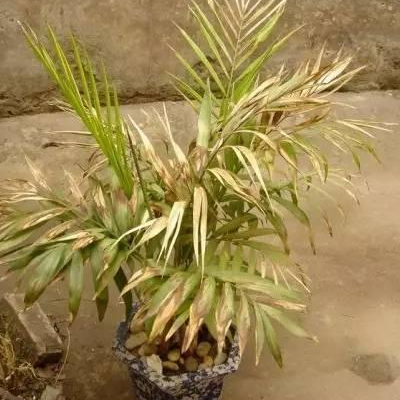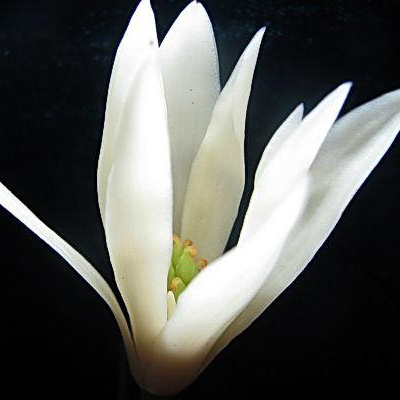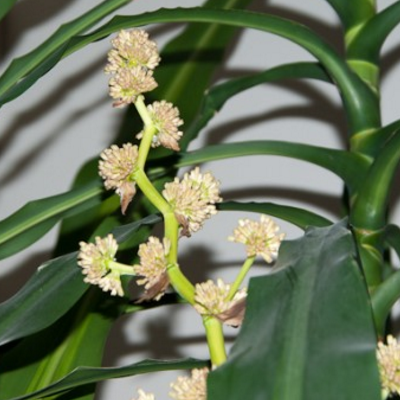What are the daily maintenance skills for loose-tailed sunflower leaves to turn yellow and dry?
Loose-tailed sunflower, generally indoor breeding, made of potted, this loose-tailed sunflower leaves yellow dry how to do? What are the daily maintenance skills of sunflower:

What if the loose-tailed sunflower leaves turn yellow and dry:
It is necessary to talk about the growing environment that loose-tailed sunflower likes. It is a tropical foliage plant. It likes a warm and humid environment. When the summer temperature is high, it can appropriately increase the frequency of watering, and keep the environment ventilated.
Spray water around and on the plants properly when the air is dry, the leaves are yellow or withered easily when the air is dry, so that the branches and leaves can remain green and grow better.
This should also be the case in winter. if the indoor temperature is kept above 10 degrees, the frequency of watering must be less, and the basin soil can be properly replenished only when the soil is completely dry, but it is also important to spray water occasionally and maintain a certain amount of air humidity.
Daily maintenance skills of sunflower:
1. Watering and humidity
Summer temperature is higher, water consumption is very fast, for those who see light loose tail sunflower, can appropriately increase watering, ensure sufficient soil moisture, often spray water on branches and leaves, maintain humidity, in the state of high temperature and high humidity, its growth state will be better, it is not easy for the yellow leaves to dry up.
2. Curing temperature
It is a tropical plant, which should be kept warm and moist all the year round. The lowest temperature should be kept above 7 degrees. When the summer temperature exceeds 35 degrees, it should be properly cooled. At this time, it can spray water on and around the ground to cool down. The best temperature for its growth is between 1830 degrees.
3. Other maintenance notes:
If you want to raise sunflower well and master environmental humidity, watering and appropriate temperature, there is basically no problem. It has little demand for light, so don't let it be exposed to the sun and maintain it. Scattered light can be seen appropriately. It is also no problem to keep it in bright indoor light.
If you see some dry or yellow branches and leaves, they can be cut off in time, while some branches and leaves that grow weakly or are too dense can be built properly and can be properly pruned in winter.
The maintenance of loose-tailed sunflower does not need regular fertilization, but can be given thin fertilizer once in spring and autumn to keep the basin soil loose and fertile and good drainage.
4. Pest control
If diseased spots are found in sunflower leaves, such as spots or withered leaves, they should be treated as soon as possible, cut off the diseased leaves thoroughly, and spray carbendazim solution in time.
Daily maintenance pay attention to maintain a high environmental humidity, otherwise it is easy to induce red spiders.
The treatment of yellowing and bitter taste of loose-tailed sunflower leaves is introduced here, and it is necessary to protect it every day.
What if the leaves of sunflower turn yellow?
The reason for the yellowing of sunflower leaves-- soil discomfort
Indoor potted sunflower should choose acidic soil, the acidity of the soil is not enough, which will affect the absorption function of the root system and cause the leaves to turn yellow.
Loose-tailed sunflower is suitable for sandy loam cultivation, if the potted soil is too sticky, it will cause part of the root system to rot at the end, then the leaves begin to yellowing, and the plant grows poorly or even dies.
The reason for the yellowing of loose-tailed sunflower leaves-improper transplantation
Transplanting upper pot is an important step for families to plant sunflower, and improper operation will lead to yellowing of plant leaves. When potting, it is necessary to remove the outer part of the root system, but the outer root system is the main root system of root respiration. if it is damaged by improper operation, the plant nutrition supply can not be supplied, and the plant will gradually gaunt and die. And the sign of death is that the leaves turn yellow and droop.
The reason for the yellowing of loose-tailed sunflower leaves-too much watering
Loose-tailed sunflower is higher, and the nutrients needed by leaves depend on root transport. Proper watering can quickly absorb the roots and keep the leaves green, but if the basin soil is too wet, it will affect the root respiration, affect the root water absorption, and directly cause the leaves to yellowing.
The reason for the yellowing of loose-tailed sunflower leaves-too little watering
It is no good to water too much or too little. Sunflower needs sufficient water during its growth. When the basin soil is dry for a long time, because the growth of the plant does not get enough water, the leaves will begin to turn yellow and wither.
The reason for the yellowing of loose-tailed sunflower leaves-- low humidity
The growth of loose-tailed sunflower needs higher air humidity, and when the air is too dry, the leaves will slowly turn yellow. Water should be sprayed on the leaf surface and the surrounding environment 3 or 4 times a day throughout the growth period to increase air humidity. However, watering should be stopped after dormancy (after winter).
The reason for the yellowing of sunflower leaves-- the temperature is too low
Loose-tailed sunflower likes to be warm, and it is necessary to do a good job of heat preservation and anti-freezing in winter. generally, about 10 ℃ can survive the winter safely. if the temperature is too low, the plant suffers frost injury, the leaves turn yellow and the leaf tip dries up, which leads to root damage and affects the growth of the coming year.
The reason for the yellowing of sunflower leaves-- the sun is too strong
The growth of sunflower needs plenty of sunlight, but it needs proper shade from May to September. During this period, excessive light can easily lead to plant leaf burns, which is what we often call sunburn. The leaves appear yellow spots and become scorched and yellowed. Over time, the whole plant will wilt. So in summer, the plants should be kept under shade sheds or big trees to avoid direct sunlight.
The cause of yellowing of loose-tailed sunflower leaves-- pest infection
Leaf mites and shell insects are relatively common pests in loose-tailed sunflower. When leaf mites or shell insects grow in the leaves of loose-tailed sunflower, pests cause damage to plants, and loose-tailed sunflower will begin to turn yellow. If you do not take measures such as spraying, loose-tailed sunflower will die slowly.
The yellowing of loose-tailed sunflower leaves is a common problem in potted sunflower planting. there are many reasons for the problem, and the solutions are also different, but all we need is our careful care.
What if the leaves of loose-tailed sunflower turn yellow? exposure to the sun can easily make the leaves yellow.
Loose-tailed sunflower is a tropical plant, which likes warm, humid and semi-shady environment. The cold tolerance is not strong, and the leaves turn yellow when the temperature is below 20 ℃. If you don't pay attention, you can disperse the leaves of sunflower. So, what if the leaves of sunflower turn yellow? Let's take a look at it.
First, what if the leaves of loose-tailed sunflower turn yellow?
The main results are as follows: 1. Improper transplantation leads to yellowing of loose-tailed sunflower leaves: transplanting upper plate is a thing that needs to be done to plant loose-tailed sunflower in potted plants. dig out the plant on the pot, to remove part of the peripheral root system, and the outer fine root is the main root system that plays the role of absorption. after this part of the root system is injured, it is easy to lead to problems in nutrition supply, making the plant gradually haggard and die. It is a sign that the leaves turn yellow and droop.
Solution: when transplanting, we should be careful of the root system of sunflower, so as not to damage the root system.
2. Excessive watering leads to yellowing of loose-tailed sunflower leaves: overwatering is also one of the reasons for the yellowing of loose-tailed sunflower leaves, which does not mean that if there is water in the basin soil, plants can absorb and utilize it. When the basin soil is too wet, it affects the respiration of plant roots, thus affecting the absorption of water by roots and causing plant leaves to yellowing.
Solution: we should water it thoroughly when watering it.
3. Long-term lack of water leads to yellowing of loose-tailed sunflower leaves (dry yellow): it is not good to water too much or too little. During the growth period, loose-tailed sunflower needs to supply sufficient water. When the basin soil is dry for a long time, because the growth of the plant does not get enough water, the leaves will begin to turn yellow and wither.
Solution: we should pay attention to watering the sunflower during the growth period.
4. Sun exposure leads to yellowing of loose-tailed sunflower leaves (burning yellow): loose-tailed sunflower likes the semi-overcast environment from May to September, and there will be some phenomena such as leaf yellowing, focal tip, focal edge and so on in direct sunlight.
Solution: during this period should be placed in the shade or under the tree, avoid direct sunlight.
5. Low humidity leads to yellowing of loose-tailed sunflower leaves: loose-tailed sunflower likes higher air humidity, and when the air is too dry, it will cause the leaves to turn yellow slowly.
Solution: spray water on the leaf surface and the surrounding environment 3 or 4 times a day throughout the growth period to improve air humidity. But stop watering after dormancy.
6, the temperature is too low to lead to loose-tailed sunflower leaves yellowing: loose-tailed sunflower likes warmth, need to do a good job of heat preservation and anti-freezing in winter, generally about 10 ℃ can be relatively safe to survive the winter, if the temperature is too low, the leaves will yellowing, leaf tip dry, and lead to root damage, affecting the growth of the coming year.
The solution: in the northern winter, we have to transplant the sunflower into the greenhouse for the winter.
7. Excessive fertilization will lead to yellowing of leaves (fat yellow): excessive fertilization will cause reverse osmosis of plant root cells and make the plant lose water. If the degree is light, it will lead to the focal tip and edge of leaves, and in serious cases, it will cause rotten root death.
Solution: when applying fertilizer, we should apply it according to the amount of sunflower needed.
8. Diseases and insect pests lead to yellowing of loose-tailed sunflower leaves: leaf mites and shell insects are relatively common pests of loose-tailed sunflower. When leaf mites or shell insects grow on loose-tailed sunflower leaves, pests cause damage to plants, and loose-tailed sunflower will begin to turn yellow. if you do not take measures such as spraying treatment, loose-tailed sunflower will die slowly.
Solution: apply pesticides to save the sunflower.
Second, the maintenance experience of loose-tailed sunflower
1. Loose-tailed sunflower is afraid of cold and has weak cold tolerance. The lowest temperature for overwintering is above 10 ℃. The country of origin can be as high as 380 m. Outdoor culture in northern China usually enters the room from late September to early October and must be placed in a place with sufficient sunshine. During the overwintering period, the room temperature is 23: 25 ℃ during the day and 15 ℃ at night, or at least 8 ℃ or more, otherwise it will suffer frost injury and cause death in winter and spring.
February and May to October is the prosperous period of its growth, so it is necessary to provide sufficient water and fertilizer conditions. Generally, rotten liquid fertilizer or compound fertilizer is applied every 1-2 weeks to promote the vigorous growth of the plant, the leaf color is thick green, fertilize less or not in autumn and winter, and keep the basin soil dry and wet at the same time.
- Prev

What if the leaves turn yellow in the culture of white orchids?
White orchid, the flowering of this plant is more beautiful, the flower is relatively large, how is this white orchid culture method? White orchid leaves yellowing how to do: White orchid culture method: (1) because it is neither drought-resistant nor wet-resistant. Therefore, in summer and autumn, because of the higher temperature, it evaporates faster.
- Next

What if the Brazilian wood grows too high? what if the leaves turn yellow?
Brazilian wood, this kind of plant is liked by many people, and it is super good-looking at home. What if this Brazilian wood grows too high? What if the Brazilian wood leaves turn yellow: what if the Brazilian wood grows too high: if your Brazilian wood grows too tall, at this time, you need to prune the trees.
Related
- Fuxing push coffee new agricultural production and marketing class: lack of small-scale processing plants
- Jujube rice field leisure farm deep ploughing Yilan for five years to create a space for organic food and play
- Nongyu Farm-A trial of organic papaya for brave women with advanced technology
- Four points for attention in the prevention and control of diseases and insect pests of edible fungi
- How to add nutrient solution to Edible Fungi
- Is there any good way to control edible fungus mites?
- Open Inoculation Technology of Edible Fungi
- Is there any clever way to use fertilizer for edible fungus in winter?
- What agents are used to kill the pathogens of edible fungi in the mushroom shed?
- Rapid drying of Edible Fungi

